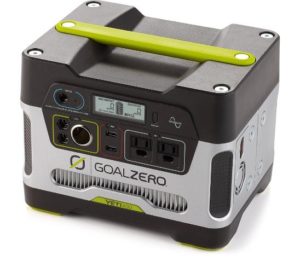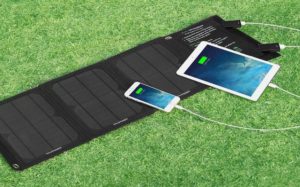Review: Best portable electronics charger for camping, music festivals
We all want to stay connected. Whether on Montage or Hunter Mountain, the Gorge, or dry camping with friends, canoeing the Suwannee River, or rafting near Red Rocks, we want our electronics to keep on going and going and going… So what’s the best way to charge and recharge your iPhones, cameras, and drones if a 110v electrical outlet is not readily available? One of readers recently asked, and RoadtripMojo explores the options…
There really is no one best way.

If weight and storage are not a factor, a small, 700-1000 watt gas inverter generator will make easy work of any recharge. Noise is kept to a quiet hum, but you still must keep it away from people and pets to avoid the exhaust. It is, after all, a combustion engine, and you will need a couple of disposable propane cylinders (or small tank) to get you through a three- or four-day fest or camping trip with your friends. One of these gennies costs between $400 to $900, and requires some maintenance. The units are small and relatively light, tipping the scales at around 25 pounds. They will run many devices and small appliances, albeit not all at once. A good choice are the newer Ryobi and Generac units.

A greener solution is what some refer to as a portable battery inverter generator or power pack. It’s basically a large battery with convenience features for charging the unit from your home outlet, car or the sun, and has ports for charging a variety of devices. Usually, an LCD display gives you information on amount of charge and voltage draw by an attached device. Often the size of a lunchbox or larger, they are manageable by one person, but don’t plan on hiking with one. They weigh around 20 pounds, depending on the capacity. And they don’t come cheap, with units from Kalisaya (Kalipak – with solar panel) and Goal Zero costing $300 to $1000 or more; off-brand Chinese models may be as low as $200 to $600. All of these units are basically very large, fancy backup batteries. They may charge a half dozen small electronic devices a half dozen times or more, depending on size/capacity. Some are full kits with solar panels and other accessories to charge, and some are sold as a single unit without extras.
The two options listed above are definitely for the power user that is going to need lots of charging for many camping trips. It’s an investment that will only pay off if heavily used. For occasional festival charging on a much friendlier budget, we suggest a portable solar panel to charge your standard phone backup batteries you may already own. These are either flexible thin film panels, or rigid monocrystalline panels. As long as there is sun, you can always recharge.
Our picks in this category are the Ravpower and Choetech flexible panels that sell for under $40. Most manufacturers claim higher output from their panels

than their panel will actually deliver, even here in sunny South Florida where we test and use ours regularly. The panels in this price/watt range are sufficient for charging your phones and small electronic devices, provided there is ample sun to charge effectively. They typically deliver 8-10 watts, though the manufacturer will rate them at 15-18 watts. It’s nice to have limitless charging capacity. Easy to share with friends, you’ll be a hit in the energy-starged festival campgrounds.
Perhaps the simplest, and least expensive option is to buy three or four small back-up batteries, perhaps one for each day of the fest, and have them fully charged before heading out for the festival. The small batteries we’ve used typically will charge a smart phone a few times, so one a day should keep at least your smartphone going the entire fest. If you are only interested in keeping your phone, and maybe a small digital camera charged, this may be the most simple solution. The downside is that if you deplete your back up batteries, you’re done.
Whether your travels take you to the music festival grounds or deep into the woods, the right power source can ensure your phone, digital camera, and other electronics keep on going and going and going…
